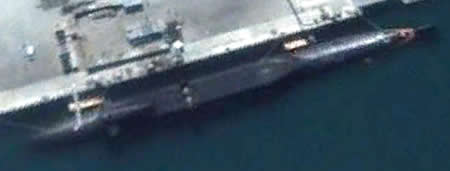 |
| One of China’s two Jin-class SSBNs with two open missile tubes. Click for larger image. |
.
By Hans M. Kristensen
One of China’s two new Jin-class SSBNs was photographed with two of its 12 missile tubes open when it visited Xiaopingdao Naval Base in March 2009.
The Jins are being readied to carry the JL-2, a single-warhead regional sea-launched ballistic missile that was most recently test-launched in May 2008. The class may become operational soon and replace the old Xia from 1982.
Xiaopingdao Naval Base, which is where I identified the Jin-class for the first time in 2007, serves as an outfitting and testing facility for new submarines and used to be the homeport of the single Golf-class diesel submarine China used for many years as a test launch platform for its first ballistic missile.
Two or three Jin-class SSBN have been under construction, and it remains to be seen if China will build up to five as projected by U.S. intelligence. China’s nuclear submarines appear to be the noisiest nuclear submarines in the world and will probably be highly vulnerable at sea.
The U.S. Office of Naval Intelligence described in August 2009 that two of China’s SSBNs (probably one Jin and the Xia) were based at the Northern Fleet Base in Jianggezhuang, and the third boat (probably the second Jin) at the Southern Fleet Base on Hainan Island. I identified the Jin at Hainan in February 2008.
The Obama administration’s first version of The Military Power of the People’s Republic of China is expected within the next month or two.
This publication was made possible by a grant from Carnegie Corporation of New York and Ploughshares Fund. The statements made and views expressed are solely the responsibility of the author.
Satellite imagery has long served as a tool for observing on-the-ground activity worldwide, and offers especially valuable insights into the operation, development, and physical features related to nuclear technology.
This report outlines a framework relying on “Cooperative Technical Means” for effective arms control verification based on remote sensing, avoiding on-site inspections but maintaining a level of transparency that allows for immediate detection of changes in nuclear posture or a significant build-up above agreed limits.
The grant comes from the Carnegie Corporation of New York (CCNY) to investigate, alongside The British American Security Information Council (BASIC), the associated impact on nuclear stability.
Satellite imagery of RAF Lakenheath reveals new construction of a security perimeter around ten protective aircraft shelters in the designated nuclear area, the latest measure in a series of upgrades as the base prepares for the ability to store U.S. nuclear weapons.